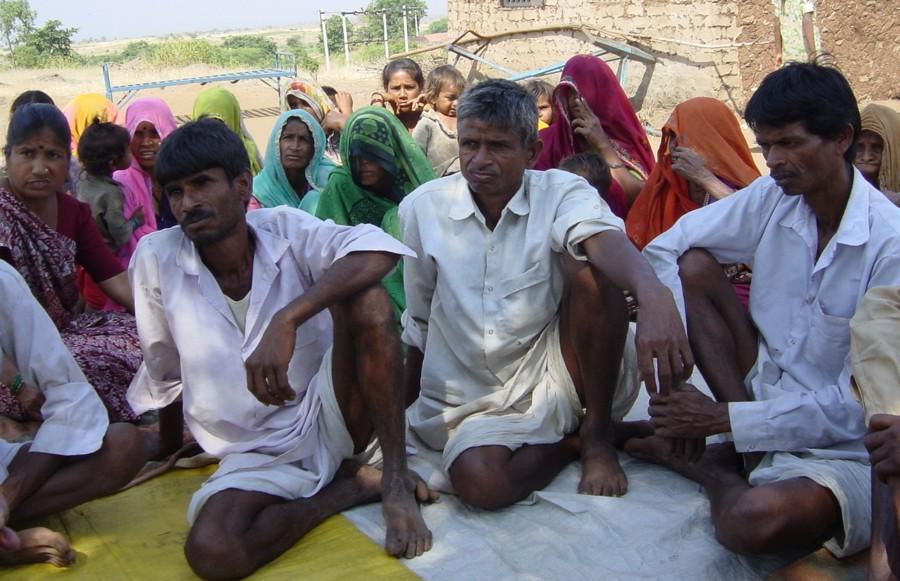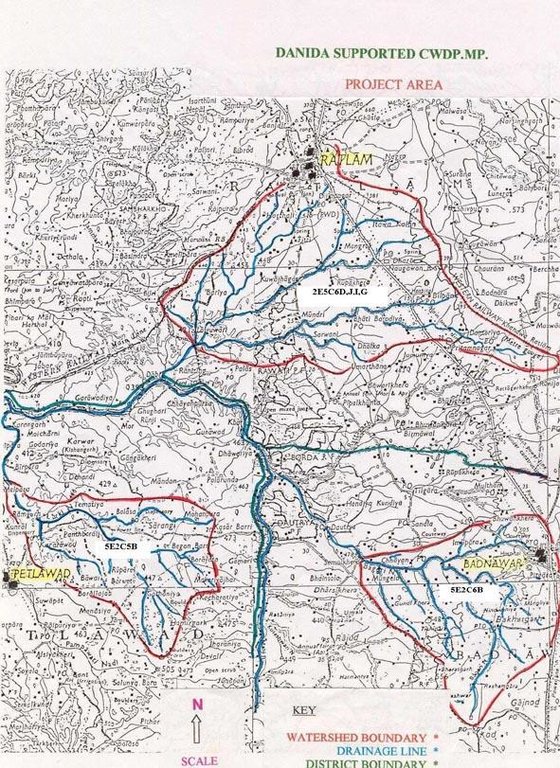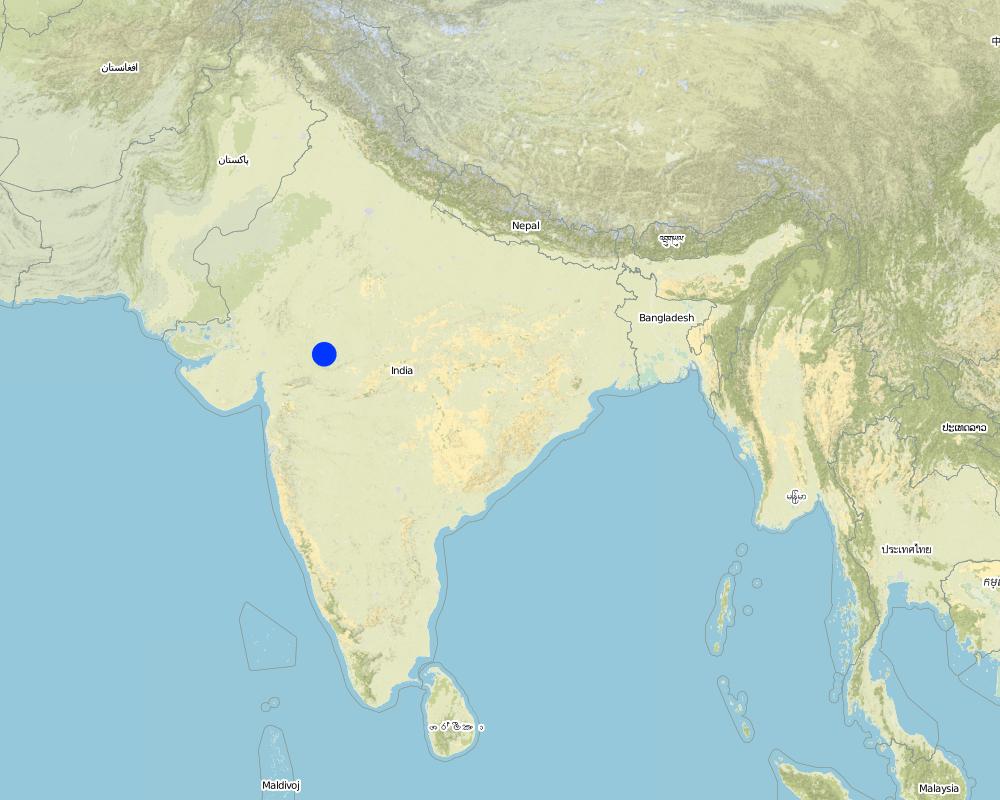Comprehensive watershed development [الهند]
- تاريخ الإنشاء:
- تحديث:
- جامع المعلومات: David Gandhi
- المحرر: –
- المراجعون: Fabian Ottiger, Deborah Niggli
approaches_2374 - الهند
عرض الأقسام
توسيع الكل طي الكل1. معلومات عامة
1.2 تفاصيل الاتصال بالأشخاص الرئيسيين لمصدر المعلومات والمؤسسات المعنية بتقييم وتوثيق النهج
متخصص في الإدارة المستدامة للأراضي:
متخصص في الإدارة المستدامة للأراضي:
متخصص في الإدارة المستدامة للأراضي:
متخصص في الإدارة المستدامة للأراضي:
Desai Nilesh
SAMPARK, Raipuria, Tehsil- Petlawad, Distt. Jhabua (MP)
الهند
متخصص في الإدارة المستدامة للأراضي:
متخصص في الإدارة المستدامة للأراضي:
متخصص في الإدارة المستدامة للأراضي:
Bhattacharya Tapan
Lok Biradari Trust, Indore (MP)
الهند
اسم المشروع الذي سهّل توثيق/تقييم النهج (إذا كان ذلك على صلة)
Book project: where the land is greener - Case Studies and Analysis of Soil and Water Conservation Initiatives Worldwide (where the land is greener)اسم المؤسسة (المؤسسات) التي سهلت توثيق/تقييم النهج (إذا كان ذلك على صلة)
Danida assisted Karnataka Watershed Development Project, Bijapur (Danida assisted Karnataka Watershed Development Project, Bijapur) - الهنداسم المؤسسة (المؤسسات) التي سهلت توثيق/تقييم النهج (إذا كان ذلك على صلة)
Lok Biradari Trust - الهند1.3 الشروط المتعلقة باستخدام البيانات الموثقة من خلال WOCAT
يوافق جامع المعلومات والشخص (لاشخاص) الرئيسي لمصدر المعلومات على الشروط المتعلقة باستخدام البيانات الموثقة من خلال WOCAT:
نعم
1.4 المراجع الخاصة باستبيان(استبيانات) تقنيات الإدارة المستدامة للأراضي
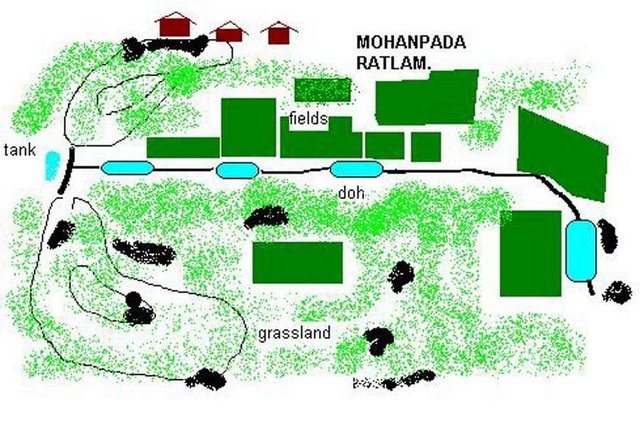
Sunken streambed structure [الهند]
Excavations in streambeds to provide temporary storage of runoff, increasing water yields from shallow wells for supplementary irrigation.
- جامع المعلومات: David Gandhi
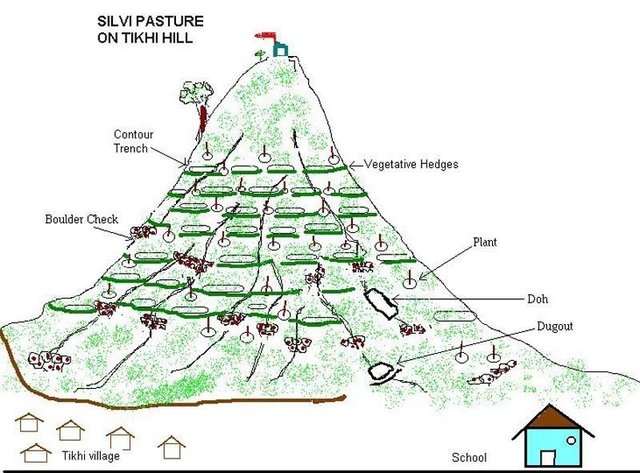
Silvi Pasture [الهند]
Regeneration of degraded hill side using structural, vegetative & managerial measures.
- جامع المعلومات: Unknown User
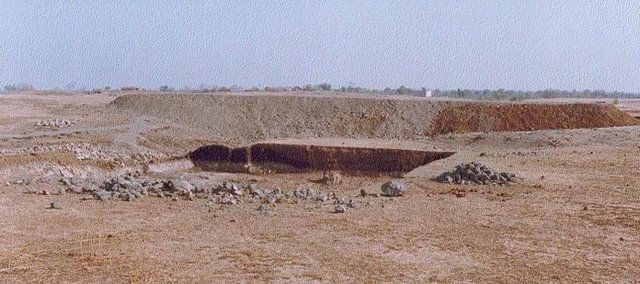
Dugout Pond [الهند]
Dugout pond is a sunken water harvesting structure constructed along the rills in upper catchment for the purpose of storage of runoff and recharge of ground water.
- جامع المعلومات: Mulchand Kag
2. وصف نهج الإدارة المستدامة للأراضي
2.1 وصف موجز للنهج
Participatory approach that includes a package of measures leading to empowerment of communities to implement and sustain watershed development.
2.2 وصف تفصيلي للنهج
وصف تفصيلي للنهج:
Aims / objectives: The approach adopted under the Comprehensive Watershed Development Project (CWDP) is intended to ensure sustainability of development interventions. This can only be achieved through creating a sense of 'ownership' amongst users, which means involving the community in planning, implementation and management of the interventions. A further, specific objective is to benefit vulnerable sections of the community.
Methods: Various methods are employed to achieve these goals. There is, first of all, awareness generation within the community through exposure visits outside the area, street theatre and video shows. After this comes the formation and capacity building of village level institutions, in particular the Village Watershed Development Committees (VWDCs). Users' groups are also formed. Micro-planning (under a 'village development plan') using participatory rural appraisal (PRA) follows. There are arrangements to ensure participatory execution of the plan, specifying cost and benefit sharing (on average 75%-90% of the work is paid for in cash under this approach). Another important element is to ensure user rights to resources. This entails negotiation with government for rights to produce from common land. Eventually, after initial implementation, management becomes the task of the users' groups: this includes maintenance, distribution of benefits and conflict resolution. The whole process involves NGOs along with government staff in order to achieve better communication all round. The participants have different roles. Government staff (at various levels) provides technical and financial support, as well as assistance towards gaining user rights over resources. NGOs are particularly important in awareness generation and mobilisation, capacity building of village level institutions, and in the process of negotiation with the Government.
Role of stakeholders: The village committee is central in planning and implementation of the village development plan, and in overseeing users's groups. Users's groups are involved in planning, implementation and then resource management. The village assembly helps to identify beneficiaries and users, and to give overall support to the VWDC. An external international donor, DANIDA of Denmark, supports the Comprehensive Watershed Development Project.
2.3 صور عن النهج
2.5 البلد/المنطقة/المواقع التي تم تطبيق النهج فيها
البلد:
الهند
المنطقة/الولاية/المحافظة:
Madhya Pradesh
Map
×2.6 تواريخ بدء وإنهاء تنفيذ النهج
أشر إلى سنة البدء:
1997
سنة الإنهاء (إذا لم يعد النهج مطبقًا):
2007
2.7 نوع النهج
- قائم على مشروع/برنامج
2.8 الغايات/الأهداف الرئيسية للنهج
The Approach focused mainly on SLM with other activities (1- Capacity building of communities, 2- Production system)
- create a sense of ownership amongst users. - ensure sustainability of technical and social interventions. - benefit more vulnerable sections of the community, including the poor and women. - involve the community in planning, implementation and management interventions
The SLM Approach addressed the following problems: previous lack of consultation/involvement with the community in planning, implementation and management of watershed development interventions
2.9 الظروف التي تمكن أو تعيق تنفيذ التقنية/التقنيات المطبقة بموجب النهج
المعايير والقيم الاجتماعية /الثقافية/ الدينية
- معيق
Lack of awareness and mobilisationon improvement of production systems.
Treatment through the SLM Approach: Intensive programme for awareness generation and mobilisation of community
توفر/الوصول إلى الموارد والخدمات المالية
- معيق
Treatment through the SLM Approach:
الإطار المؤسساتي
- معيق
Lack of effective institutions at village level to take responsibility for the development process.
Treatment through the SLM Approach: Formation & capacity building of VLI (VWDC,UG) with assistance of NGOs.
الإطار القانوني (حيازة الأراضي، وحقوق استخدام الأراضي والمياه)
- معيق
Uncertainity fover rights to access to resources
Treatment through the SLM Approach: Negotiations facilitated by NGOs
The existing land ownership, land use rights / water rights moderately hindered the approach implementation While treatment of privately owned land did not face a problem, encroachment on Govt. land was an obstacle which discouraged land users from implementing SWC on these lands. Furthermore it was not possible to obtain users rights on lands under the Forest Department, which resulted in their exclusion from SWC in most cases. The NGOs involved however acted as intermediaries in negotiations.
المعرفة حول الإدارة المستدامة للأراضي، والوصول إلى الدعم الفني
- معيق
High cost water harvesting measures.
Treatment through the SLM Approach: Demonstration of low cost alternatives such as the doh (sunken structure in dry riverbed to increase infiltration of runoff, which replenishes wells for irrigation: see 'related technology').
3. المشاركة وأدوار الأطراف المعنية
3.1 أصحاب المصلحة المعنيون بالنهج وأدوارهم
- مستخدمو الأراضي المحليون/المجتمعات المحلية
Specific ethnic groups: While the main group were Bhil tribal, other groups included Gujars, Patidars etc.
Due to social factors, traditionally decision making largely done by men. However, the project has worked towards involving women in all aspects of the project. Participation of women in decision making bodies such as village committee is restricted . Participation of women is good in implementation, self-help groups etc. The project is active in neediest & most degraded villages which are fairly homogenous in nature. Furtherore efforts are made to identify and benefit poorest households.
- منظمة غير حكومية
- الحكومة المحلية
Village Watershed Development Committee, Users Group.
- الحكومة الوطنية (المخططون، صانعو القرار)
Govt. of India/ Govt. of Madhya Pradesh, Department of Agriculture.
- منظمة دولية
Danida
إذا كان هناك العديد من الأطراف المعنية، قم بالإشارة إلى الوكالة الرائدة:
The broad approach was developed by national and international specialists at the time of project appraisal. The detailed pedagogy was developed by the project in consultation with NGO partners and consultants.
3.2 انخراط مستخدمي الأراضي المحليين/المجتمعات المحلية في المراحل المختلفة للنهج
| انخراط مستخدمي الأراضي المحليين/المجتمعات المحلية | حدد من شارك وصف الأنشطة | |
|---|---|---|
| المبادرة/التحفيز | تفاعلي | Mainly:public meetings; partly: awareness generation; Community meeting for discussion. Street plays, exposure visits for awareness generation. |
| التخطيط | تفاعلي | Mainly: rapid/participatory rural appraisal; partly: group meeting; Preparation of village plan. Discussion on village plan. Negotiation, Decision making. |
| التنفيذ | تفاعلي | responsibility for minor steps; Landusers provide labour, partly subsidized by project. VWDC members involved in supervision & payments. |
| الرصد/التقييم | تفاعلي | measurements/observations; Water levels, migration rates monitored by community with project staff. Gram sabha (Village assembly) meets every 3-6 months to discuss project activity. VWDC meets monthly to take stock. |
| Research | سلبي | on-farm; studies carried out by project staff. |
3.3 مخطط التدفق (إذا كان متاحًا)
الوصف:
CWDP-MP: Comprehensive Watershed Development Project in Madhya Pradesh PIP: Project Implementation Plan VWDC: Village Watershed Development Committee
3.4 اتخاذ القرار بشأن اختيار تقنية/تقنيات الإدارة المستدامة للأراضي
حدد من الذي قرر اختيار التقنية/التقنيات التي سيتم تنفيذها:
- متخصصون في الإدارة المستدامة للأراضي بشكل أساسي، بعد التشاور مع مستخدمي الأراضي
اشرح:
exposure visits' to outside demonstration sites are used as a tool for sensitisation, motivation and awareness raising.
Decisions on the method of implementing the SLM Technology were made by mainly by land users supported by SLM specialists. Discussion with VWDC,UG.
4. الدعم الفني وبناء القدرات وإدارة المعرفة
4.1 بناء القدرات/التدريب
هل تم تقديم التدريب لمستخدمي الأراضي / الأطراف المعنيين الآخرين؟:
نعم
حدد من تم تدريبه:
- مستخدمو الأراضي
- SWC specialists, extensionists/trainers
شكل التدريب:
- في العمل
- دورات
شكل التدريب:
- exposure visits
المواضيع المغطاة:
1- Training for VWDC, UG, SHG's to conduct meetings, accounts and book-keeping. 2- Technical trainings. These are provided by government and NGO staff. Training concentrates on participatory approaches and low cost technologies. Capacity building for community groups and land users enables them to participate better in projects and to take ownership of assets.
4.2 خدمة استشارية
هل يملك مستخدمو الأراضي وصولا إلى خدمة استشارية؟:
نعم
حدد ما إذا كانت الخدمة الاستشارية متوفرة:
- في حقول مستخدمي الأراضي
وصف/تعليقات:
Name of method used for advisory service: Multi Disciplinary Teams; Key elements: Field staff drawn from different Govt. line deptt. and NGO's., Village level workers selected locally, paid by the Project through NGOs., Formation, capacity building of village level institutions and farmers.; 1) Advisory service carried out through: non-governmental agency, projects own extension structure and agents; Extension staff: Govt.+ NGO employees 2) Target groups for extension: land users; Activities: Capacity building of village institutions, demonstration of SWC measures, production
Advisory service is quite adequate to ensure the continuation of land conservation activities; The state policies now emphasise the participatory approach. However, aspects like GO-NGO cooperation need to be instutionalised.
4.3 تعزيز المؤسسات (التطوير التنظيمي)
هل تم إنشاء أو تعزيز مؤسسات من خلال هذا النهج؟:
- نعم، إلى حد كبير
حدد المستوى (المستويات) التي تم فيها تعزيز أو إنشاء المؤسسات:
- محلي
حدد نوع الدعم:
- مالي
- بناء القدرات/التدريب
4.4 الرصد والتقييم
هل يشكل الرصد والتقييم جزءا من النهج؟:
نعم
التعليقات:
bio-physical aspects were regular monitored through observations; indicators: general parameters
technical aspects were regular monitored through measurements; indicators: water levels in some wells
socio-cultural aspects were ad hoc monitored through measurements; indicators: migration
economic / production aspects were regular monitored through measurements; indicators: yield
area treated aspects were ad hoc monitored through observations; indicators: hectares treated
no. of land users involved aspects were regular monitored through measurements; indicators: attendance at meetings
There were several changes in the Approach as a result of monitoring and evaluation: Several technological changes have taken place as a result of a review: for example feedback on yield data led to crop variety recommendations. Levels of water in wells confirmed impact of the 'sunken structures' (dohs).
5. التمويل والدعم المادي الخارجي
5.1 الميزانية السنوية لمكون الإدارة المستدامة للأراضي في النهج المذكور
إذا لم تكن الميزانية السنوية الدقيقة معروفة، قم بالإشارة إلى نطاقها:
- 1,000000-100،000
التعليقات (على سبيل المثال المصادر الرئيسية للتمويل/الجهات المانحة الرئيسية):
Approach costs were met by the following donors: government (national): 5.0%; international (-): 85.0%; local community / land user(s) (labour): 10.0%
5.2 الدعم المالي/المادي المقدم لمستخدمي الأراضي
هل حصل مستخدمو الأراضي على دعم مالي/ مادي لتنفيذ التقنية/ التقنيات؟:
نعم
5.3 إعانات لمدخلات محددة (بما في ذلك العمالة)
- معدات
| حدد المدخلات التي تم دعمها | إلى أي مدى | حدد الإعانات |
|---|---|---|
| الآلات | ممول بالكامل | |
- زراعة
| حدد المدخلات التي تم دعمها | إلى أي مدى | حدد الإعانات |
|---|---|---|
| بذور | ممول جزئيا | |
| Seedlings | ممول جزئيا | |
إذا كان العمل من قبل مستخدمي الأراضي مدخلاً جوهريًا، فهل كان:
- مدفوع نقدا
التعليقات:
As is common in Indian watershed development initiatives, there is a substantial subsidy towards labour involved. under this approach 75-90% of labour input is paid for in terms of cash: the remainder is voluntary contribution
5.4 الائتمان
هل تم توفير ائتمان في إطار نهج أنشطة الإدارة المستدامة للأراضي؟:
كلا
6. تحليل الأثر والتصريحات الختامية
6.1 آثار النهج
هل ساعد النهج مستخدمي الأراضي على تنفيذ وصيانة تقنيات الإدارة المستدامة للأراضي؟:
- لا
- نعم، قليلا
- نعم، باعتدال
- نعم، إلى حد كبير
The participatory approach has been fairly successful in demonstrating SWC technologies such as Silvi Pasture, Sunken Structures which have been adopted/maintained by the land users.
هل أدى النهج إلى تحسن في مسائل حيازة الأراضي / حقوق المستخدمين التي أعاقت تنفيذ تقنيات الإدارة المستدامة للأراضي؟:
- لا
- نعم، قليلا
- نعم، باعتدال
- نعم، إلى حد كبير
By using the approach, the project was able to win the confidence of most land users.
Did other land users / projects adopt the Approach?
- لا
- نعم، قليلا
- نعم، باعتدال
- نعم، إلى حد كبير
The pilot project which has tested the approach over past 3-4 years is implemented by the Department of Agriculture. The State Department of Agriculture has now expanded the approach to its other projects eg. NWDPRA.
6.3 استدامة أنشطة النهج
هل يمكن لمستخدمي الأراضي المحافظة على استدامة ما تم تنفيذه من خلال النهج (بدون دعم خارجي)؟:
- غير مؤكد
إذا كان الجواب لا أو غير متأكد، حدد ذلك وعلق عليه:
1- NGO's will contrinue to visit villages where project has completed bio-physical activities for a period of 2-3 years with a view to provide support and further training to VLI's & communities. Hence it is pre-mature to comment at this stage.
6.4 نقاط قوة/مزايا النهج
| نقاط القوة/ المزايا/ الفرص من وجهة نظر مستخدمي الأراضي |
|---|
| Awareness about SWC increased through street plays, exposure visits. Use of drama preferred to verbal communication. (How to sustain/ enhance this strength: Continue, and include visits to successful income generating projects.) |
| Participatory planning has led to better understanding of resources and possibilities (How to sustain/ enhance this strength: The entire village plan should be implemented in defined stages to allow impact to be noted/felt.) |
| Cost-sharing increases feeling of ownership. (How to sustain/ enhance this strength: Community contribution should be deposited in the village fund to enable further activities after project moves out.) |
| Due to village institutions, there is greater decentralisation of ressponsibility and more people are actively involved. |
| As a result of village fund, interest component remains within the village. |
| Increased transparency as a result of GO-NGO cooperation. (How to sustain/ enhance this strength: Less rigidity in roles of GO/NGO staff.) |
| نقاط القوة/ المزايا/ الفرص من وجهة نظر جامع المعلومات أو غيره من الاشخاص الرئيسيين لمصدر المعلومات |
|---|
| Marginalised groups have been identified and given a 'say' (How to sustain/ enhance this strength: NGOs should continue to advise/guide/monitor activities) |
| Systematic approach to strengthen community participation (How to sustain/ enhance this strength: Detailed 'process documentation' to be continued.) |
| Leadership developed at village level. (How to sustain/ enhance this strength: NGO's continue to advise/guide/monitor activities in the village.) |
| Land users develop a strong sense of ownership of the assets created. (in terms of cost-sharing, a local contribution of up to 25% is high in Indian contexts) (How to sustain/ enhance this strength: There needs to be continued support for 2-3 years after phasing out of bio-physical watershed development activities; also important to build up village funds through a 'community contribution' charge deducted from wages.) |
| Government system can be strengthened by co-operation with NGOs in watershed management projects (How to sustain/ enhance this strength: Continue dialogue between partners at various levels..) |
6.5 نقاط الضعف/ العيوب في المنهج وطرق التغلب عليها
| نقاط الضعف/ المساوىء/ المخاطر من وجهة نظر مستخدم الأراضي | كيف يمكن التغلب عليها؟ |
|---|---|
| Formation of User group creates conflict with surrounding villages. | |
| Segregation of responsibilities of GO-NGO staff viz. NGO role restricted to community organisation while GO staff deal with technical asspects. | Better integrated teamwork should be the goal. |
| A 'community contribution' charge is currently deducted equally from all villagers by the project from wages paid | Contribution to be deposited in village fund., Should be a greater voluntary contribution from the richer farmers. |
| Participation in various meetings at village level is cumbersome for women, resulting in increased pressure from male family members and loss of wages. | |
| Project duration for planning and implementation too short | Increase the timespan to 3 years or more. |
| Women not adequately involved in exposure visits. | Correct this imbalance/arrange separate visits for women. |
| Exploitation by middlemen when small farmers market produce not addressed by the project. | Group marketing of produce. |
| نقاط الضعف/ المساوىء/ المخاطر من وجهة نظر جامع المعلومات أو غيره من الاشخاص الرئيسيين لمصدر المعلومات | كيف يمكن التغلب عليها؟ |
|---|---|
| Because of low literacy levels NGO support to village level institutions is required for more than just short-term | Adult literacy classes of sufficient duration are needed. |
| PRA brings out many social factors that are beyond the scope of the project to influence eg the feudal system | NGOs need to have broadbased activity platforms that can address these issues as they arise. |
| Shortage of female staff restricts contact with women land users. | Gender sensitization, training for project staff intensified. |
7. المراجع والروابط
7.1 طرق جمع/مصادر المعلومات
- زيارات ميدانية، مسوحات ميدانية
- مقابلات مع مستخدمي الأراضي
7.2 المراجع للمنشورات المتاحة
العنوان، المؤلف، السنة، النظام القياسي الدولي لترقيم الكتب ISBN:
'Participatory approaches in watershed management- successful experinces' David Gandhi 2002
متاح من أين؟كم التكلفة؟:
Indian Association of Soil Conservation, Central Soil & Water Conservation Research & Training Insti
الروابط والوحدات المواضيعية
توسيع الكل طي الكلالروابط

Sunken streambed structure [الهند]
Excavations in streambeds to provide temporary storage of runoff, increasing water yields from shallow wells for supplementary irrigation.
- جامع المعلومات: David Gandhi

Silvi Pasture [الهند]
Regeneration of degraded hill side using structural, vegetative & managerial measures.
- جامع المعلومات: Unknown User

Dugout Pond [الهند]
Dugout pond is a sunken water harvesting structure constructed along the rills in upper catchment for the purpose of storage of runoff and recharge of ground water.
- جامع المعلومات: Mulchand Kag
الوحدات المواضيعية
لا يوجد وحدات مواضيعية


